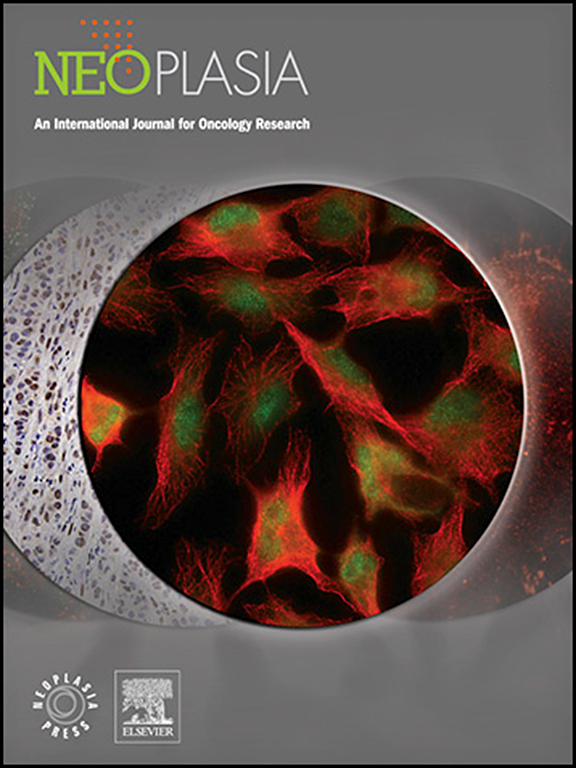YPEL2 regulates the efficacy of BRD4-EZH2 dual targeting in EZH2Y641mut germinal center-derived lymphoma
IF 7.7
2区 医学
Q1 Biochemistry, Genetics and Molecular Biology
引用次数: 0
Abstract
A significant proportion of diffuse large B cell lymphoma (DLBCL) and follicular lymphoma (FL) cases harbor a gain-of-function, heterozygous somatic mutation of the methyltransferase gene EZH2. While this factor is known to cooperate with the proto-oncogene MYC during malignant B cell development, the effect of interfering with both factors remains underexplored. Here we undertook the simultaneous evaluation of two epigenetic drugs targeting EZH2 methyltransferase activity and BRD4-mediated control of MYC transcription, CPI169 and CPI203, using preclinical models of DLBCL and FL with distinct EZH2 mutational status. We observed a specific and synergistic antiproliferative effect of these compounds in EZH2-mutated cells and mouse xenograft models, that was related to the abrogation of MYC transcriptional program and to tumor cell proliferation blockade at the G1 cell cycle phase. Gene expression profile, exploratory data analysis, and siRNA screening identified the PI3K/AKT-regulated gene and mitosis regulator, YPEL2, as a crucial factor involved in the efficacy of MYC/EZH2 dual targeting both in vitro and in vivo. Altogether, our results provide first pre-clinical evidence that simultaneous targeting of MYC and EZH2 is a safe and efficient approach that can be monitored by specific biomarkers, in aggressive lymphoid tumors of germinal center origin.
YPEL2调控BRD4-EZH2双靶向治疗EZH2Y641mut生发中心源性淋巴瘤的疗效
相当比例的弥漫性大B细胞淋巴瘤(DLBCL)和滤泡性淋巴瘤(FL)病例携带甲基转移酶基因EZH2的功能获得,杂合体细胞突变。虽然已知该因子在恶性B细胞发育过程中与原癌基因MYC合作,但干扰这两个因子的影响仍未得到充分探讨。在这里,我们利用具有不同EZH2突变状态的DLBCL和FL的临床前模型,同时评估了针对EZH2甲基转移酶活性和brd4介导的MYC转录控制的两种表观遗传药物CPI169和CPI203。我们观察到这些化合物在ezh2突变细胞和小鼠异种移植模型中具有特异性和协同的抗增殖作用,这与MYC转录程序的取消和肿瘤细胞在G1细胞周期期的增殖阻断有关。基因表达谱、探索性数据分析和siRNA筛选发现,PI3K/ akt调控基因和有丝分裂调节因子YPEL2是MYC/EZH2双靶向体外和体内疗效的关键因素。总之,我们的研究结果首次提供了临床前证据,证明同时靶向MYC和EZH2是一种安全有效的方法,可以通过特定的生物标志物来监测,用于生发中心起源的侵袭性淋巴细胞肿瘤。
本文章由计算机程序翻译,如有差异,请以英文原文为准。
求助全文
约1分钟内获得全文
求助全文
来源期刊

Neoplasia
医学-肿瘤学
CiteScore
9.20
自引率
2.10%
发文量
82
审稿时长
26 days
期刊介绍:
Neoplasia publishes the results of novel investigations in all areas of oncology research. The title Neoplasia was chosen to convey the journal’s breadth, which encompasses the traditional disciplines of cancer research as well as emerging fields and interdisciplinary investigations. Neoplasia is interested in studies describing new molecular and genetic findings relating to the neoplastic phenotype and in laboratory and clinical studies demonstrating creative applications of advances in the basic sciences to risk assessment, prognostic indications, detection, diagnosis, and treatment. In addition to regular Research Reports, Neoplasia also publishes Reviews and Meeting Reports. Neoplasia is committed to ensuring a thorough, fair, and rapid review and publication schedule to further its mission of serving both the scientific and clinical communities by disseminating important data and ideas in cancer research.
 求助内容:
求助内容: 应助结果提醒方式:
应助结果提醒方式:


